Hip Action
If there is one tip out there that could greatly improve your sailing by as much as 50 percent it would be what I call the Hip Twist. If you are not looking around you probably don’t know what’s going on and are complexly unaware of your surroundings. You will be less in tune with the fluctuations of the wind and you may find yourself being catapulted or simply coming off the plane a lot. This is exasperated if your front knee is bent and you are looking at your hands, feet or just ahead of the nose of the board. This kind of stance feels uncomfortable or out of control. A slight hip twist with your bellybutton pointing slightly more towards the nose of the board will open up you viewing range as long as you are sheeting in with your harness and not your arms. This allows you to see more clearly upwind in order to read the wind strengths before they sneak up on you!
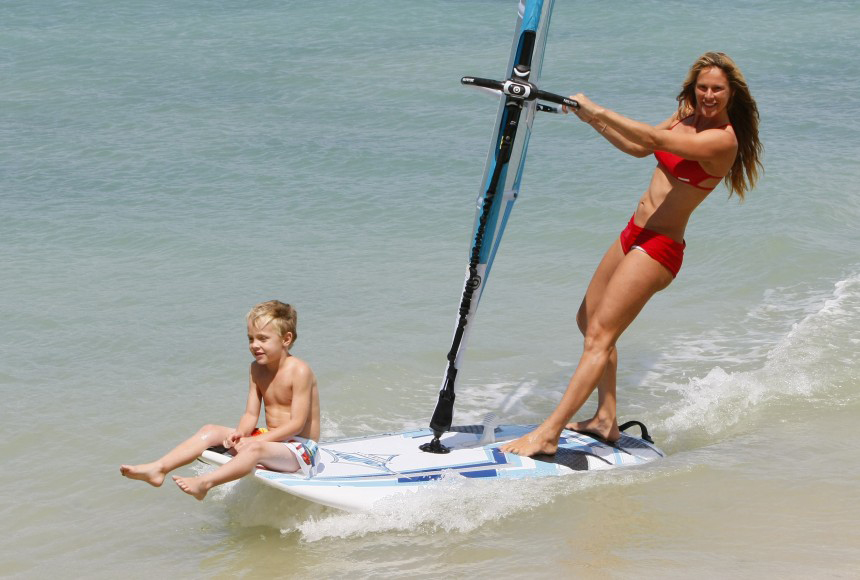
Perfect stance is the good posture of windsurfing. This standing position on your board with your hips facing slightly forward is ideal for the absolute beginner as it will allow them to fly faster through the tough learning curves of windsurfing with the correct tools. Improvers will find that the Hip Twist stance will make it that much easier to get in and out of the footstraps and harness while expert sailors will suddenly find sailing insanely over powered and getting upwind to catch those waves a cinch. The Twist is quite simple… Though perhaps like yoga it will take some time to hold the position if your flexibility and muscles need practice.
This stance is the most effective way to sail in control while being more aware of what’s going on around you, to sail slow and not end up miles down the beach. It’s your key to sailing and keeping balanced with the ever fluctuating wind without getting pulled over every time a gust or a lull hits you. Speed actually feels as though it slows down. You’ll be sheeting in correctly without even noticing it which makes for a less bumpy ride since when the sail pulls even slightly out of your hands or harness all the weight goes back on your feet and your board starts to buck like a wild horse and most likely ends in a catapult.
Finally incorporating this stance is absolutely the only way you’re ever going to get upwind making any effective ground. To achieve this stance you’ll need to twist your upper body slightly forward and towards the nose of your board.
The Twist is not useful for initiating the turn of the jibe, the bottom turn on a wave or for any other reason you might want to fly off down wind.
Position of Feet
To ease us into the twist of this stance we’ll start off with the feet. Front foot points toward the nose of the board in all positions!
Light Winds Out of the Footstraps
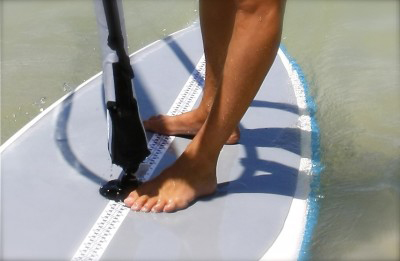
Feet further forwards toward mast track:
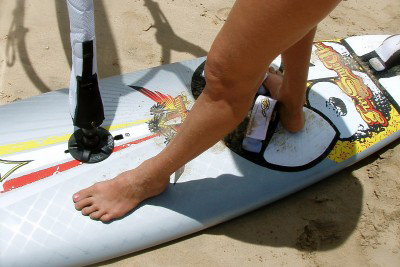
When sailing upwind in light winds the front foot moves more toward the outer edge and windward side of the board as well.
High Winds Out of the Footstraps
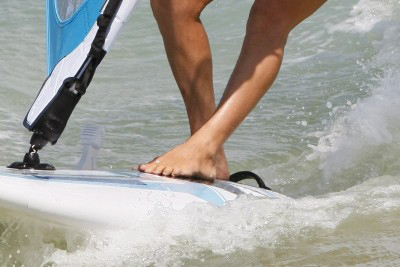
Feet further back down the board:
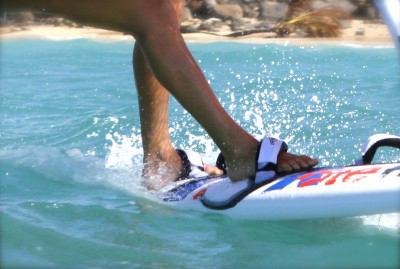
Planing in the Footstraps: Front Foot still points towards the nose of the board as much as possible.
The front foot points as much as possible towards the nose of the board whether your in the footstraps or not. Back foot remains across the board as the photos show above. If your front foot is not pointing forwards towards the nose of the board you will not be able to twist your hips forward. Experiment and you’ll see what I mean. Try twisting your hips forward towards the nose of your board with both feet facing across the board like the photo below. I bet you won’t be able to twist. Now try twisting you hips forward with your front foot facing forward like the pictures above. It’s much easier isn’t it? Again whether in the footstraps or not the position of your feet are the most important component for achieving the proper twist in order to have a pro windsurfer like sailing stance.
Less Effective Footwork
Twisting the upper body forward becomes almost impossible with the front foot position below! Better to point the front foot a little more forward towards the nose of our board by bringing your front foot heel inboard as much as possible.
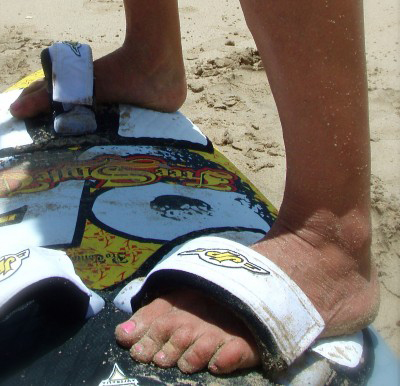
The Hips
Simply twist your hips slightly forward and attempt to point your belly button towards the nose of the board as much as possible whether you’re in the footstraps and harness or not. When you’re fully committed to the harness the twist will be very helpful with keeping the sail balanced and sheeted in along with some commitment to the harness and some ‘hips up and down action’ to counteract the strength of the wind. High and light wind sailing is another article.
Belly button slightly toward the nose of the board:
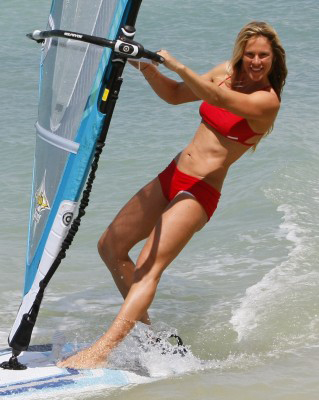
A moderate hip twist action using no footstraps or harness:
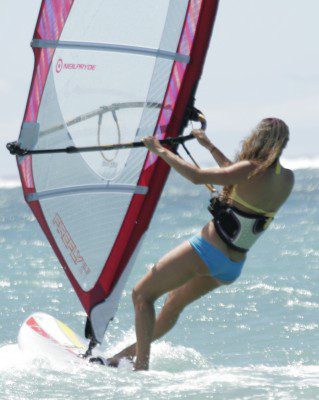
… a harness only ‘Twist’:
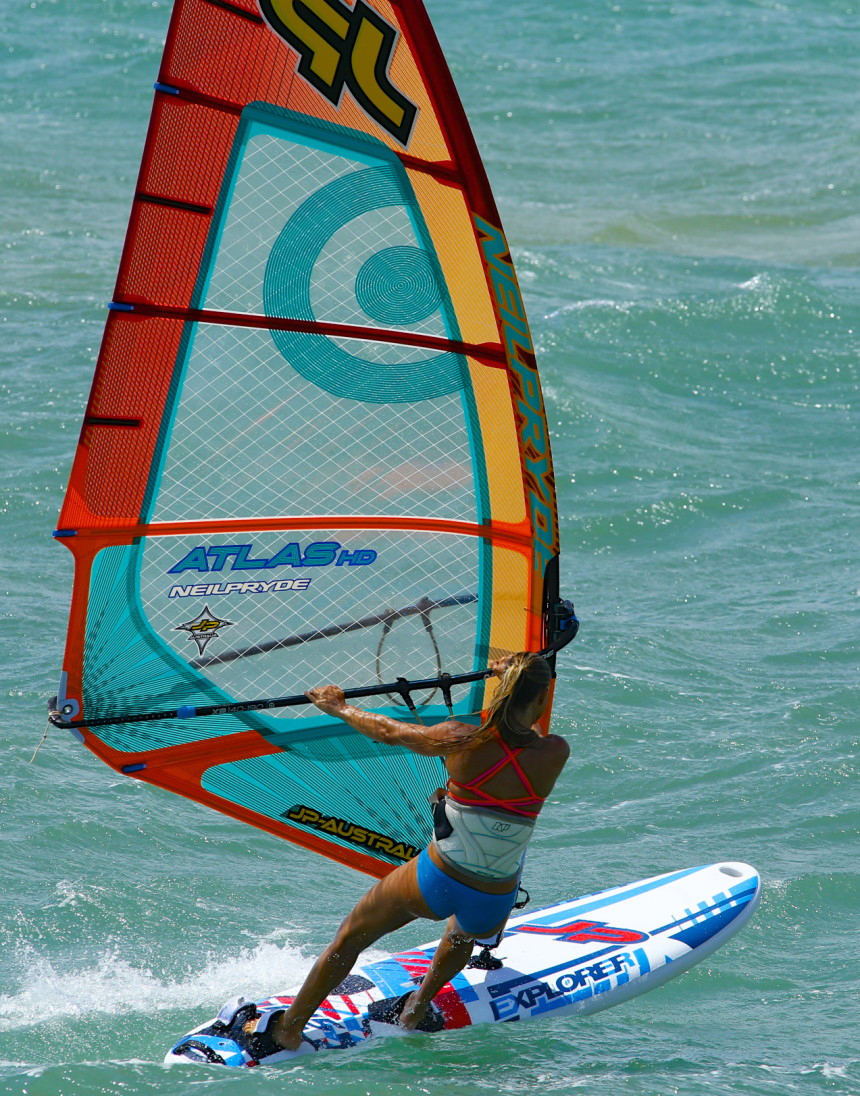
The Hip Twist in the footstraps and harness:
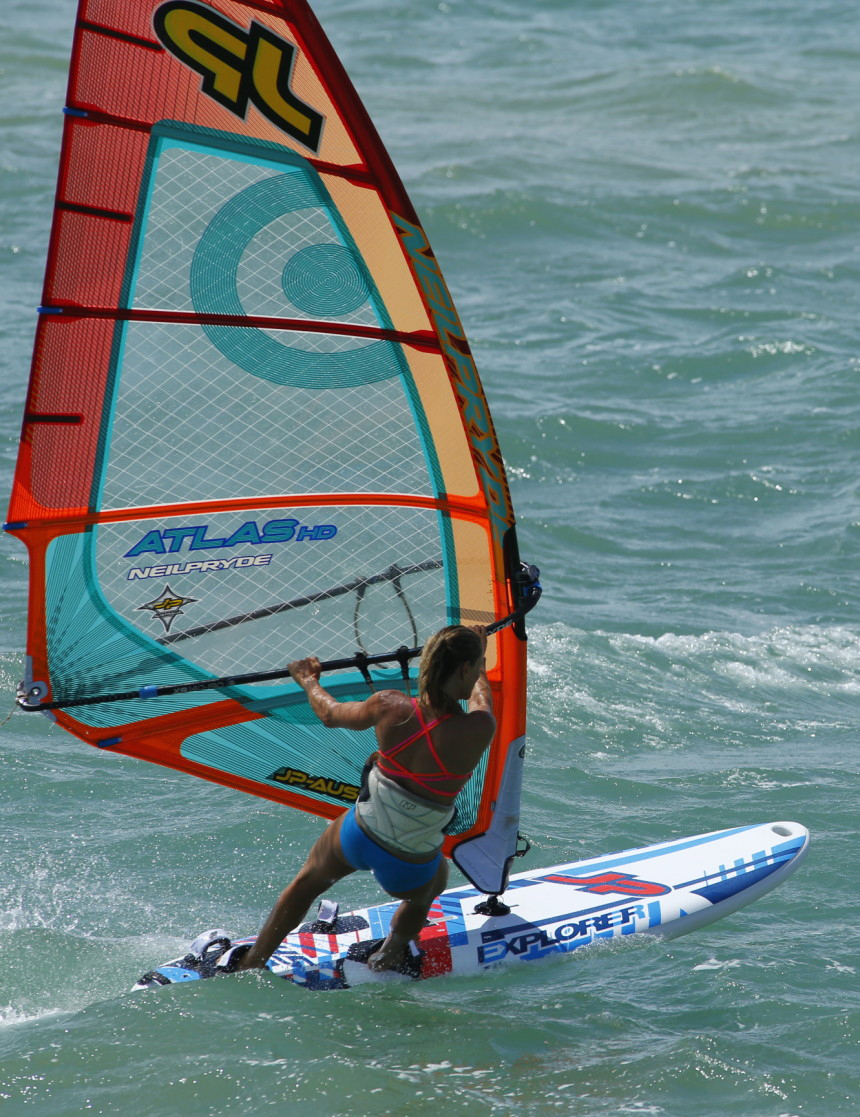
…and to the extreme for going upwind.
When you twist to the extreme while planing in the footstraps and harness you’ll head upwind without a bother as long as you’ve got some pressure on the back foot as well. Just make sure you don’t head too much upwind as that will make you stall the board!
The Hips
The head should be looking into wind or just upwind from the nose of the board. Firstly the body follows the direction the head is looking starting with the shoulders. If you look way upwind you’ll head upwind, adversely if you look down you’re going to probably fall down! Looking through your sail is only good when you want to initiate the turn of a jibe or a bottom turn on a wave. Secondly looking upwind while you’re sailing is crucial for reading the ripples on the water so you know what strength o f wind is coming your direction in order to adjust you stance accordingly. Should you see a lull you’ll want to start lifting your weight up and towards the nose of the board and if you see a gust you’ll want to start sinking down over the back leg and into the harness in order to manage the gust so you don’t get pulled over. Even if you are completely incapable of reading the strength of the wind racing along the water towards you, by looking in the right direction upwind you will eventually start to connect the style of ripples on the water blowing towards you with the strength or lack of wind that hits you. Thus getting into the habit of looking upwind while you’re sailing will greatly improve your chances of not falling off your board due to fluctuating winds as you’ll be anticipating what’s coming your way.
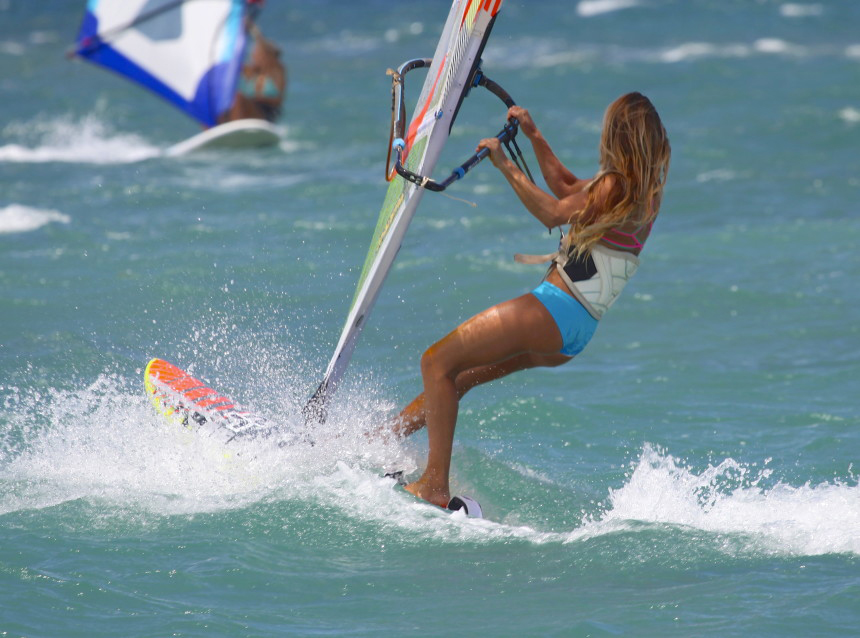
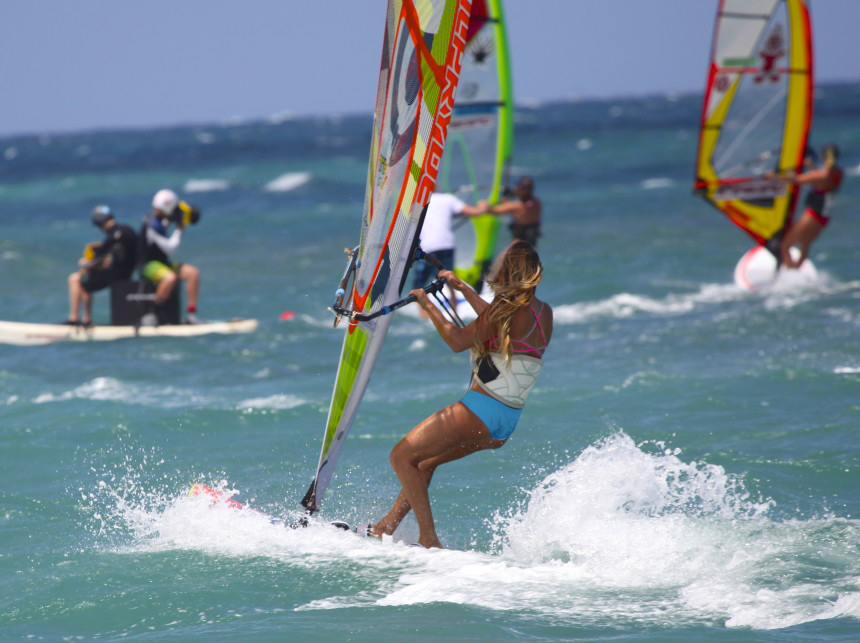
Looking upwind in search of gusts on a reach to get going.
Head position while sailing in a straight line- Note the direction I’m looking while on a broad reach… Still upwind from the nose of the board but now by torso is more squared with the sail. This only because I’d heading straight downwind to get going on purpose. As soon as I get planing I will head upwind again.
Windsurfing with shoulders squared to the sail and looking mostly through the sail while sailing across the wind or upwind is the equivalent of driving a car and looking through the side windows. It makes the feeling of speed feel a lot faster and out of control, the opposite of relaxed. You want to be relaxed while sailing!
The DOs and DON'Ts of Windsurfing Stance
Sailing while not using the footstraps or harness…
DO:

DON'T:
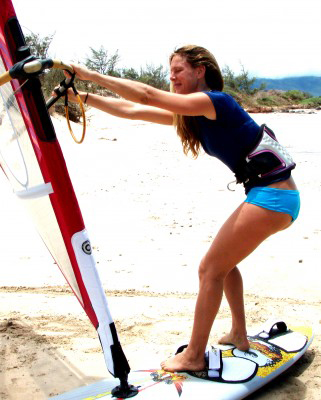
Sailing while just using the harness.
DO:
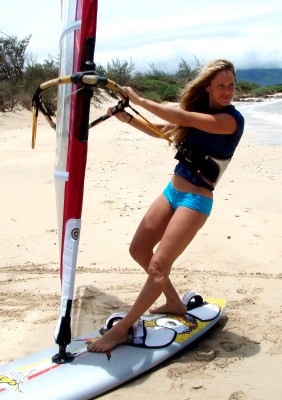
DON'T:
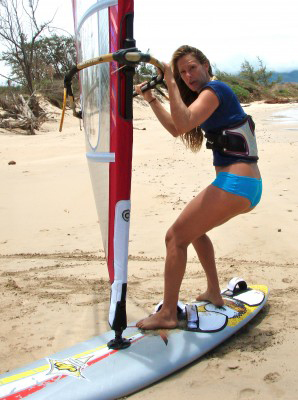
Sailing while in the footstraps and harness.
DO:
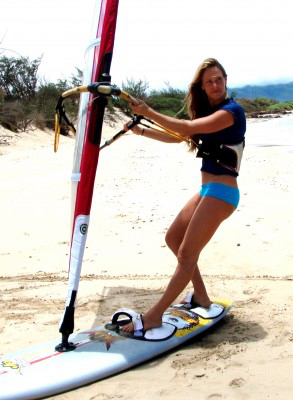
DON'T:
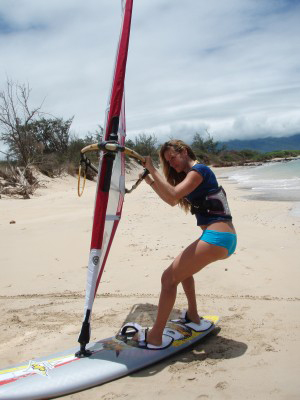
Try and look at all the DOs and DON’Ts photos and see what’s going on in the photo. For example: What are the positions of the feet, hips, shoulders and head. Hope this helps improve your stance for now. Next I’ll be covering The Low Down on Getting Low.
Happy sailing,

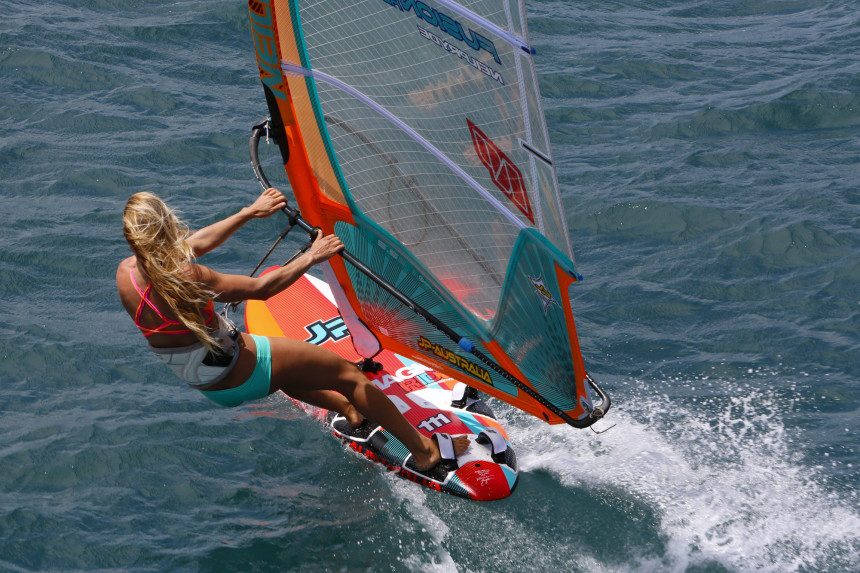


No comments.